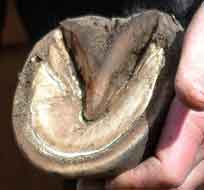Trimming feet is hard work for most women. You will find it frustrating and exhausting with dull tools; rewarding and satisfying with sharp ones.
The basic tools are the hoofpick, rasp, knife, and sharpening stick. You also need gloves and leather chaps or farrier's apron. If you are dealing with flares, a hoofstand is a big help. For people living in the desert, a Dremel tool trims rock-hard hooves.
Rasp You can get rasps at a farrier supply store, and often at your local feed store. Any brand will do, they are all similar and cost about $18 US. If you have several horses, it's worth buying a box of six and getting about 10% off.
In the dry season (when hoofs are hard), even if I soak the feet before trimming, a new rasp lasts me about 6 trims before it gets too dull to be useful. In the wet season, a rasp might last 15 trims. Men can get more than twice the use out of a rasp that I can; give your "old" ones to a farrier.
For big feet or very long heels, I sometimes use the "Legend" rasp by Heller, which has fewer and bigger teeth so it cuts faster. A regular rasp is better for smaller feet and finish work.
As a small, not-very-strong woman, I don't put a handle on my rasp. I just hold it in my (gloved) hand. This way I have more control over what it does. Don't bother with a smaller or "pony" rasp, it isn't big enough to hold onto and still have enough blade length to work.
Knife A good hoof knife that can be sharpened repeatedly to a razor-sharp edge costs about $20 US. The money is in the quality of steel; better steel holds a sharp edge longer. Don't bother with a cheap knife, it will frustrate you totally. As soon as you can afford to, buy an extra knife in case you ruin your blade on a stone. You will soon learn to clean out every grain of sand before using your tools on a hoof.
Knives come right- or left-handed.
I mostly use the Frederick Dick knife, which you can order from Star Ridge Company, 870-743-4603, www.star-ridge.com. Some farrier supply stores carry an F. Dick knife with a longer blade; it won't give you as much power and control. The one you want is the "short" knife with the rosewood handle. There are other excellent knives in a variety of shapes; I started out with a "The Knife." What's important is to pay enough to get good steel.
If you take care of your knife it should last a year or two. When it has been sharpened down till it gets narrow, throw it out. A narrow knife will eventually snap in two, cutting you or your horse's foot.
Sharpening stick or hone. My preference is the SaveEdge, which costs about $20. It's an oval metal rod coated with diamond dust, with rounded edges that make it easy to sharpen the hook of your knife.
You can get a hone at a farrier supply store. Here in the Northeast, you can order one from Northeast Farrier Supply, 1-866-333-6337, they will mail it to you. Another farrier supply that will send tools is www.northvillehorseshoe.com
The sharpening stick offered by Star Ridge Co. has "corners" on the rounded edges that will put a "missing tooth" in the hook of your knife, so I don't recommend it.
Sharpening your knife
A new hoof knife will not be sharp enough to use and will make you feel like a klutz. The knife needs to cut through the frog like cutting butter. Any dullness makes it more like trying to carve a hunk of rubber eraser.
To sharpen the knife, you need to find the correct angle for the bevel that makes the edge. Your hand and arm will learn to feel when it's right. In the beginning, follow the bevel that is there on the knife.
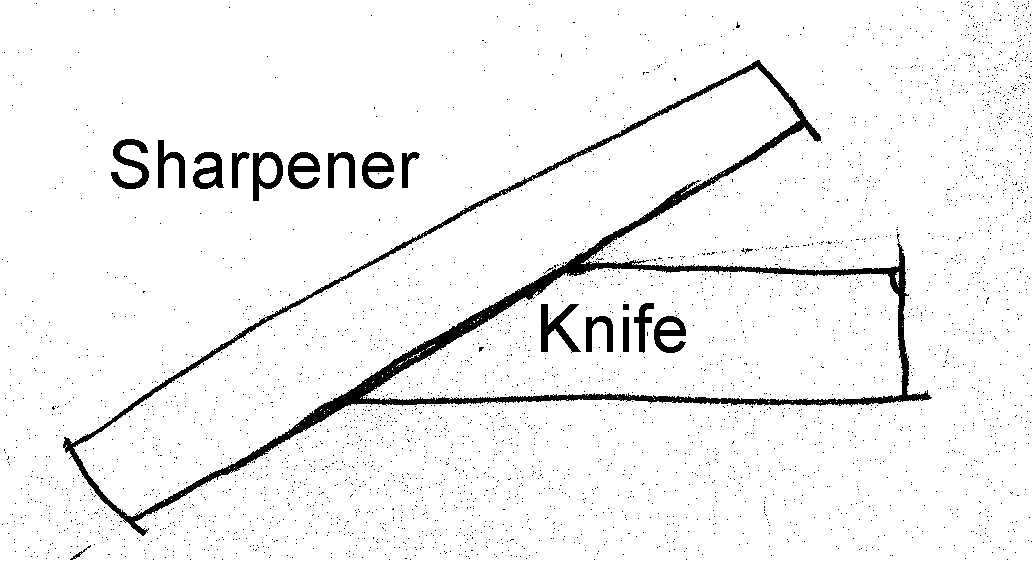
Sharpener at angle that makes a good edge.
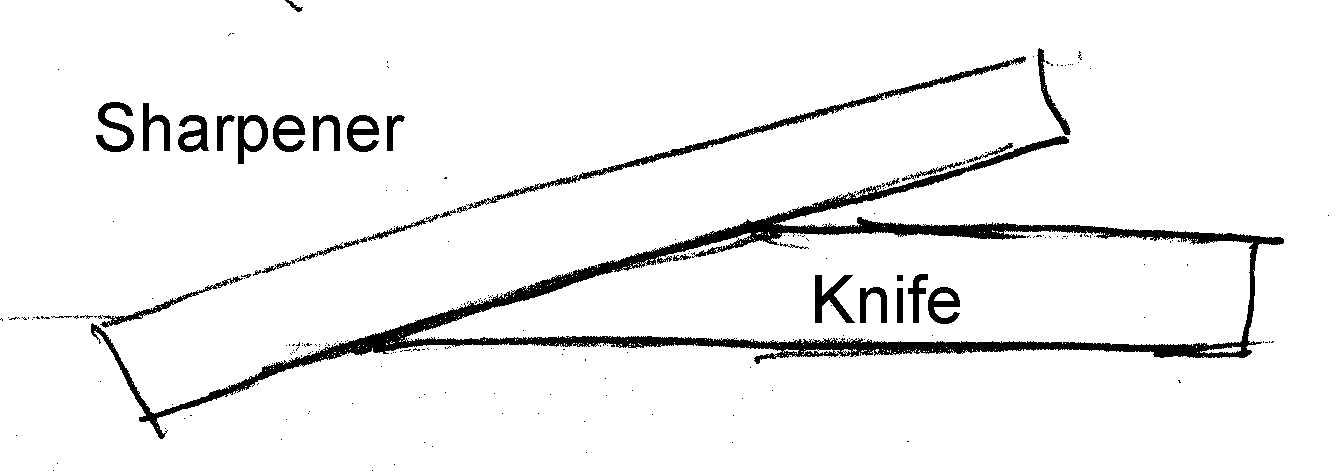
Sharpener at low angle, makes long, brittle edge that breaks easily.
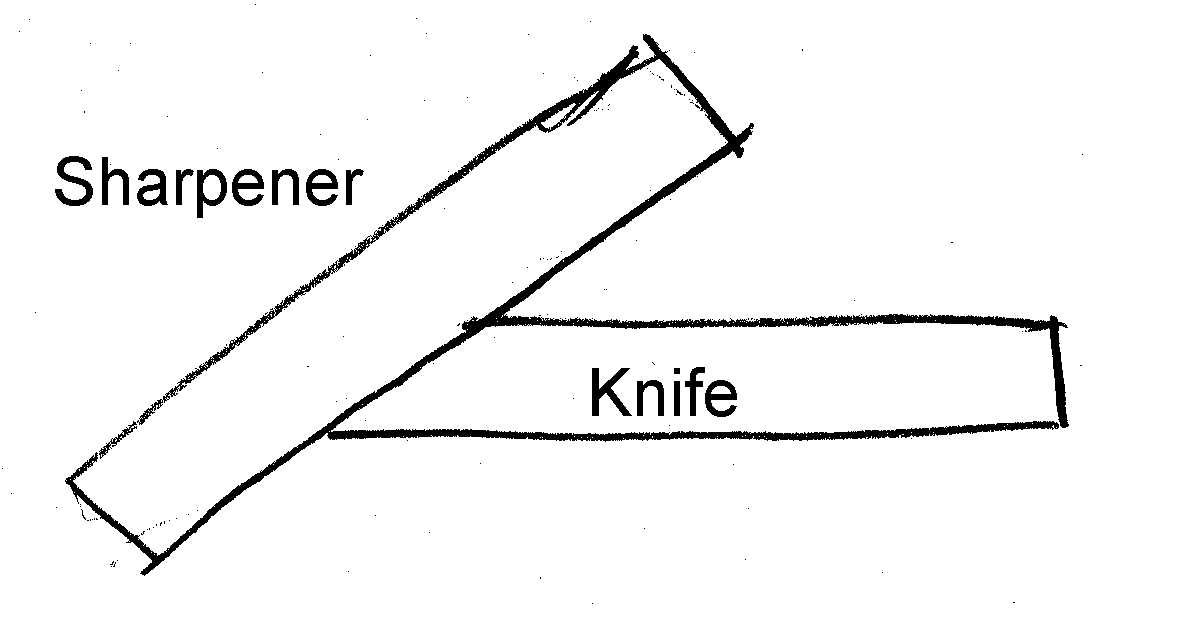
Sharpener at high angle, edge too blunt to cut well.
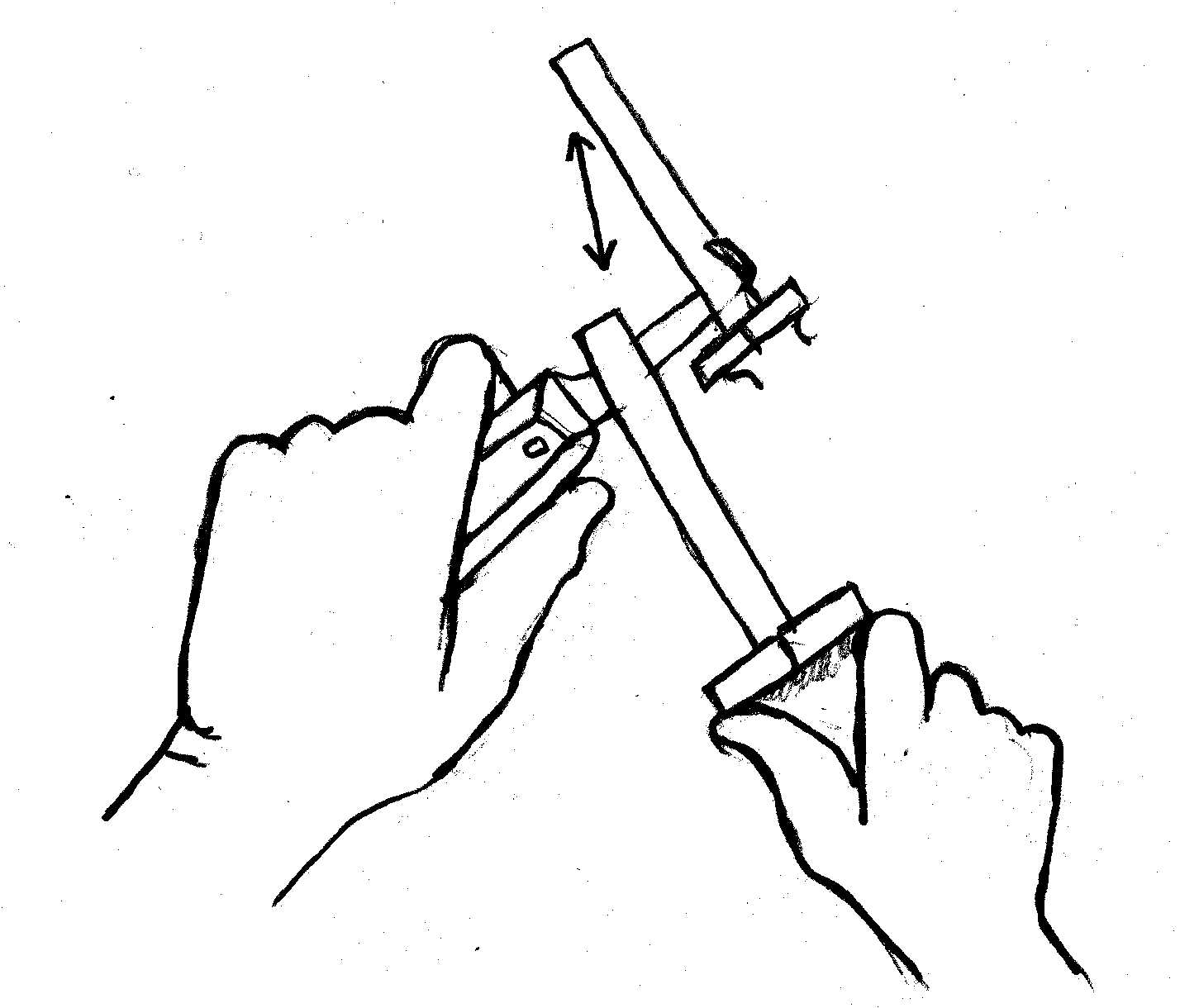
Hold both tools in a fist grip. Brace knife firmly on knee. Hold sharpener crosswise to knife, and find a good sharpening angle (see drawings above). Use a long, diagonal stroke across the knife blade, going from handle to hook, back and forth, using the whole length of both tools. Watch that you don't grind a notch just before the hook; that is your most powerful area for cutting and you want to keep a correct blade shape there.
Press firmly, you are working on steel! Only sharpen the INSIDE of the blade. Feel along the outside with your finger; if you press too hard you'll make a fine burr along the outside. Remove this with one quick, light stroke of the sharpener across the outside of the blade.
To see if your blade is sharp, stand in the sun and catch the sharp edge (not the bevel) in the sunlight. Where it's dull, you'll be able to see a tiny strip of brightness along all or part of the edge. Nicks made by grains of sand will show up clearly.
Once your new knife is well-sharpened, you will only need to do a few strokes each time before you use it. In dry weather, you may need to sharpen before each foot. On a rainy day, you can probably do all four feet on one sharpening.
Hoof stand makes it easier to work on the outside of the foot, to remove flares and do the mustang roll. Some people find it just as easy to put the foot up on their knee. This will depend on you and your horse.
I recommend you get one with adjustable height and a round base (so you can step on it from any direction). Star Ridge Company, 870-743-4603, www.star-ridge.com sells a round-base hoof stand. I recently got a Hoofjack, a green plastic stand with a sling to hold the hoof, as well as a hoof post. www.hoofjack.com
Whenever the horse's foot is up on the stand, set your foot on the base so it won't tip over. Generally it is easier for the horse to balance when the stand is higher, than lower. The best working height is about at your knee. Put the post under the horse's chin, then reach his leg up and forward. For hind legs, there is a good spot out to the side a little, from the belly.
Hoof pick with brush. You need to clean the hoof carefully before trimming. Any piece of sand or grit that's stuck in the foot will put a nick in your knife and dull your rasp.
Nippers cost $50 to $120 for quality steel that stays sharp. Women may do better with a 14-inch or smaller nipper; I use a 12-inch pony nipper. You will not need nippers if you trim your horse every 1 to 4 weeks; in fact they're useless on a foot that's kept in good trim.
If you get into trimming for your friends, and end up buying nippers for when you do "first trims," be CAREFUL never to get a finger between the nipper blades. Keep a rubber band around the handles when not in use. They are dangerous!
DO NOT use nippers to pull a shoe. It ruins the sharp edge permanently on the nails; I learned the hard way. There is a similar-looking, blunt tool called a "shoe puller," for pulling shoes.
The "Bud" Nipper has compound leverage (easier to use) and replaceable blades. Available for $150 from its inventor, Bud. Phone/FAX 307-739-9645. I don't have one yet but would like to.
Farrier's apron protects your legs and knees from the knife and rasp; remember horses sometimes grab their leg away. If you don't want to buy an apron right away, you can make one from an old pair of pants that's big enough to fit loosely over your jeans. Cut the backs out of the legs and sew a couple of extra layers and a layer of leather onto the whole front of the thighs, to below the knee. An old pair of riding chaps is OK too.
A pair of industrial-grade knee pads from hardware store or builders' supply, are great for winter and for wet conditions. "Monster" brand knee pads have a wide neoprene band around the back of your knee, very comfortable. With kneepads, you don't have to worry what you're kneeling in (snow, manure, etc.). This lets you go down on one knee and rest the horse's foot on the other knee.
Gloves are crucial. Buy several pairs of cheap leather gloves ($6-8) whenever you find them. Or you can get knit gloves with the fingers dipped in blue rubber, available at hardware stores for about $6. They are more "grippy" than leather, though hot in summer.
An arm guard is necessary in the summer when your (left) forearm isn't covered by layers of clothing. After I put several holes in my arm, a friend made me one out of leather and Velcro. Another choice is child-size soccer shin-guards. Your arm guard should cover your (left) arm snugly from wrist to the inside crease of your elbow. It protects when you have to cut towards that arm with your knife. Without it... the tendons that work your fingers, and the nerve supply to your hand, are right there.
Ruler or tape measure. You may want to measure length and width on the bottom of each foot, and keep a record of how your horse's feet change over the first year. Also needed for ordering boots.
Dremel tool A small, hand-held "hobby" power tool with assorted grinding burrs. The stone burrs are best for hooves. Helpful if you live in a dry area where the feet get rock-hard. Available at the hardware store.
The Dremel likes to dig a hole in the hoof if you leave it in one spot. Be sure to keep it moving!
Mechanic's stool with wheels available in the automotive section of chain department stores. If you have a smooth, flat surface to work on, this can be a back-saver. I prefer standing so my arms have room to move, but lots of people like to use a stool.
